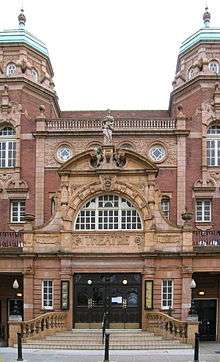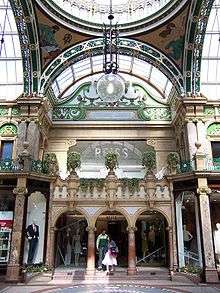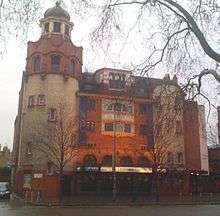Frank Matcham

Frank Matcham (22 November 1854 – 18 May 1920) was an English theatrical architect and designer. He was known for his designs of many British theatres including those of the Moss Empires group and in London the Hackney Empire (1901); the London Coliseum (1904); the London Palladium (1910) and the Victoria Palace (1911).
Born in Newton Abbot, Devon, Matcham was apprenticed to the architect, George Sondon Bridgeman, before moving to London where he joined the architectural practice of Jethro Robinson, who was at that time consulting theatre architect to the Lord Chamberlain's office. He completed his first solo design of the Elephant and Castle theatre which opened in June 1879. Between 1890 and 1915, Matcham helped train, Bertie Crewe and W.G.R. Sprague, and all three were responsible for the design and construction of over 200 theatres and variety palaces in the United Kingdom.
Early career
Frank Matcham was born in Newton Abbot, Devon. His father was a brewery clerk, who was raised in Torquay, where he attended Babbacombe school. In 1868, Matcham was apprenticed to a local surveyor and architect, George Sondon Bridgeman. In the mid-1870s, Matcham moved to London and joined the architectural practice of Jethro Robinson, consulting theatre architect to the Lord Chamberlain's office. In 1877, Matcham married Robinson's youngest daughter, Effie, and, at the age of 24, took charge of the architectural practice on the death of his father-in-law. Matcham received no formal training as an architect, but learnt the practicalities on the job. His first solo commission was to complete Robinson's designs for the Elephant and Castle theatre (opened June 1879).[1]
Career
Matcham and two architects he helped to train, Bertie Crewe and W.G.R. Sprague, were together responsible for the majority - certainly more than 200 - of the theatres and variety palaces of the great building boom which took place in Britain between about 1890 and 1915, peaking at the turn of the century.
Matcham himself designed: The interior of the Theatre Royal, Newcastle; Everyman Theatre, Cheltenham (1891); the Blackpool Grand Theatre, the Theatre Royal, Wakefield and the Buxton Opera House (1894); the Regent Theatre, Salford (1895);[2] the Royal Hall (Kursaal) in Harrogate (1903); and the Liverpool Olympia (1905). He also designed several famous London theatres: the Hackney Empire (1901); the London Coliseum (1904); the London Palladium (1910); the Victoria Palace (1911). Matcham is remembered in Northern Ireland for his design of the Grand Opera House (opened December 1895) on Great Victoria Street, Belfast. In Douglas, Isle of Man he designed the Gaiety Theatre, which survives to this day.

Matcham also designed theatres in Scotland: in Aberdeen, there were His Majesty's Theatre, built in 1904 to replace the Tivoli Theatre - the Tivoli was originally known as Her Majesty's Theatre, opened in 1872 to the designs of C.J. Phipps, and was subject to alterations by Matcham in 1897, followed by a complete interior rebuild by him in 1909. Both theatres still survive in Aberdeen, although the Tivoli is disused after a spell as a bingo hall. In Edinburgh, he designed the Empire Palace Theatre, opened in 1892, and he also rebuilt it after a fire in 1911. It was subsequently demolished and rebuilt in 1927/8, this time to the designs of Sunderland architects Milburn and Milburn. The theatre still stands today, having been refurbished, after a time as a bingo hall, as the Edinburgh Festival Theatre; it now incorporates a modern glass facade built in 1994. Matcham also designed the King's Theatre, Glasgow on Bath Street in 1904 which is still in use. In Portsmouth the Kings Theatre and the New Theatre Royal are still active.
One unusual commission, built around 1900, is the three blocks in Briggate, Leeds, that are today known as the Victoria Quarter. Matcham's Empire Palace Theatre, which was the centre-piece of the design, was demolished in the 1960s and replaced with a Harvey Nichols store, but his surviving exteriors and the County Arcade were later refurbished.
Matcham was among the pioneers in the use of steel cantilevers in his designs, and took out patents to protect his work. This allowed balconies to be built out into the theatre without the use of pillars supporting each tier. These had characterised the work of the previous generation of theatre architects. Without pillars, there were improved sight lines and, popular with theatre owners, an increased audience capacity.[3]
Matcham died on 18 May 1920 at 28 Westcliff Parade, Westcliff-on-Sea, Essex.[4] He is buried in Highgate Cemetery.[5]
On 22 November 2007, Matcham was commemorated by a blue plaque at the site of his London home, 10 Haslemere Road, Hornsey.[6]
Gallery of architectural work
 The Hackney Empire in August 2005
The Hackney Empire in August 2005- Blackpool Opera House (1889)
.jpg) Grand Theatre, Blackpool (1894)
Grand Theatre, Blackpool (1894)- Grand Opera House, Belfast (1895)
 Blackpool Tower Ballroom (1897-98)
Blackpool Tower Ballroom (1897-98) Richmond Theatre, Richmond, London (1899)
Richmond Theatre, Richmond, London (1899) County Arcade, Leeds (c.1900)
County Arcade, Leeds (c.1900) County Arcade, Leeds (c.1900)
County Arcade, Leeds (c.1900) County Arcade, Leeds (c.1900)
County Arcade, Leeds (c.1900)- London Hippodrome (1900)
 Gaiety Theatre, Douglas, Isle of Man (1900)
Gaiety Theatre, Douglas, Isle of Man (1900).jpg)
 Buxton Opera House (1903)
Buxton Opera House (1903) Shepherd's Bush Empire (1903)
Shepherd's Bush Empire (1903) London Coliseum (1904)
London Coliseum (1904) The King' Theatre, Glasgow (1904)
The King' Theatre, Glasgow (1904) His Majesty's Theatre, Aberdeen (1906)
His Majesty's Theatre, Aberdeen (1906) The London Palladium (1910)
The London Palladium (1910) Victoria Palace Theatre, London (1911)
Victoria Palace Theatre, London (1911) Bristol Hippodrome Auditorium (1912)
Bristol Hippodrome Auditorium (1912) Bristol Hippodrome Auditorium Dome (1912)
Bristol Hippodrome Auditorium Dome (1912)
References
- ↑ Frank Matcham Society, accessed 10 May 2012.
- ↑ "The Regent Theatre of Varieties, and Assembly Rooms, Cross Lane, Salford". arthurlloyd.co.uk. Arthur Lloyd.
- ↑ Michael Sell Frank Matcham - Theatre Architect, arthurlloyd.co.uk, accessed 10 May 2013
- ↑ Principal Probate Registry, Calendar of the Grants of Probate and Letters of Administration made in the Probate Registries of the High Court of Justice in England, p. 195.
- ↑ "Who's Here", Highgate Cemetry, accessed 1 July 2016.
- ↑ "MATCHAM, FRANK (1854-1920)", English Heritage, accessed 1 June 2016.
Bibliography
- Brian Walker (ed) Frank Matcham; Theatre Architect Belfast (1980)
- David Wilmore (ed) Frank Matcham & Co Dacre (2008)
External links
| Wikimedia Commons has media related to Frank Matcham. |
- Frank Matcham Society
- Theatres built by Frank Matcham
- Frank Matcham page
- Frank Matcham and Company at the Victoria and Albert Museum.